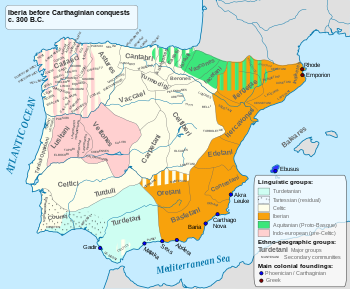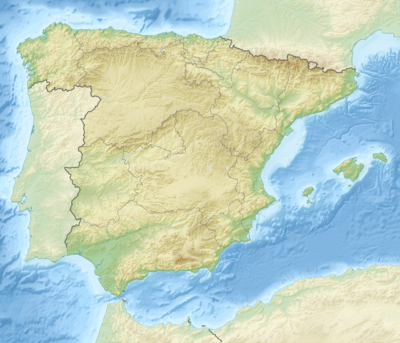
The Turduli (Greek Tourduloi) or Turtuli were an ancient pre-Roman people of the southwestern Iberian Peninsula.
Location

The Turduli tribes lived mainly in the south and centre of modern Portugal – in the east of the provinces of Beira Litoral, coastal Estremadura and Alentejo along the Guadiana valley, and in Extremadura and Andalusia in Spain. Their capital was the old oppidum of Ibolca (sometimes transliterated as Ipolka), known as Obulco in Roman times, and which currently corresponds to the city of Porcuna, currently located between the provinces of Córdoba and Jaén. Apart from Ibolca, the pre-Roman towns most strongly associated with the Turdulli include Budua (Badajoz), Dipo (Guadajira), Mirobriga (Capilla), and Sisapo (Almadén).
Origins
While they are sometimes described, in the available ancient sources, as being related ethnically to the neighboring Turdetani of Baetica (modern Andalusia), the exact ethnic origins remain obscure. The only evidence regarding the original Turdulian language are a few funerary inscriptions. Linguistic studies of these texts suggest that the early Turduli spoke an Indo-European language. Some scholars in the past, have put forward evidence that the language belonged to the Anatolian branch of Indo-European and was similar, in particular, to Paeonian-Mysian. There may also have been cultural links to the Ligurians and Illyrians (who were native to the western Balkans).
History
According to the 4th century BC Greek geographer and explorer Pytheas, quoted by Strabo in the 1st century AD, their ancestral homeland was located north of Turdetania (the region where was located the semi-legendary Kingdom of Tartessos, in the Baetis River valley, the present-day Guadalquivir), in the modern Spanish eastern Extremadura region, where their ancient capital Regina Tourdulorum (Reina – Badajoz) once stood.
The collapse of Tartessos in around 530 BC, and migrations by the Celtici in the 6th-5th centuries BC appear to have also caused mass migrations by the Turduli. The majority settled the middle Anas (Guadiana) basin, a region known as Beturia or Baeturia Turdulorum roughly corresponding to parts of eastern Alentejo, and the western half of the modern Badajoz and southeastern Huelva provinces, hence the name Baetici Turduli. Others went west, colonizing the central coastal Portuguese region of Estremadura and became known as Turduli Oppidani. Some went south, where they settled the present Setubal peninsula along the Tagus river mouth and the lower Sardum (Sado; Kallipos in the Greek sources) river valley as the Bardili. The remnants, designated Turduli Veteres in the ancient sources, migrated northwards in conjunction with the Celtici and ended settling the Beira Litoral, a coastal region situated along the lower Douro and Vacca (Vouga) river basins.
See also
- Bardili (Turduli)
- Cynetes
- Tartessos
- Turdetani
- Turduli Oppidani
- Turduli Veteres
- Pre-Roman peoples of the Iberian Peninsula
Notes
- "Historia e memorias da Academia R. Das Sciencias de Lisboa". 1825.
- ^ Ferreira do Amaral, Povos Antigos em Portugal... (1992), pp. 66; 69; 112-113; 120-121; 124; 137; 162; 189.
- Strabo, Geographikon, III, 1, 6.
- Strabo. Geography. pp. Book III Chapter 2 verse 11.
- Freeman, Phillip M. (2010). "10: Ancillary study: Ancient references to Tartessos". Celtic from the West. Oxbow Books, Oxford, UK. p. 322. ISBN 978-1-84217-410-4.
- Macrobius, Saturnalia, 1: 20, 25.
- Herodotus, Istoriai, II, 33; IV, 49.
- Ptolemy, Geographiké Hyphegésis, II, 5.
- Pliny the Elder, Natural History, IV, 116-118.
- Pliny the Elder, Natural History, IV, 21.
- Pomponius Mela, De Chorographia, III, 1.
- Strabo, Geographikon, III, 3, 5.
- Pomponius Mela, De Chorographia, III, 8.
- Pliny the Elder, Natural History, IV, 112-113.
References
- Jorge de Alarcão, O Domínio Romano em Portugal, Publicações Europa-América, Lisboa (1988) ISBN 972-1-02627-1
- Jorge de Alarcão et alii, De Ulisses a Viriato – O primeiro milénio a.C., Museu Nacional de Arqueologia, Instituto Português de Museus, Lisboa (1996) ISBN 972-8137-39-7
- Luis Berrocal-Rangel, Los pueblos célticos del soroeste de la Península Ibérica, Editorial Complutense, Madrid (1992) ISBN 84-7491-447-7
- Francisco Burillo Mozota, Los Celtíberos, etnias y estados, Crítica, Barcelona (1998, revised edition 2007) ISBN 84-7423-891-9
- João Ferreira do Amaral & Augusto Ferreira do Amaral, Povos Antigos em Portugal – paleontologia do território hoje Português, Quetzal Editores, Lisboa (1997) ISBN 972-564-224-4
- Alberto José Lorrio Alvarado, Los Celtíberos, Universidad Complutense de Madrid, Murcia (1997) ISBN 84-7908-335-2
- Ángel Montenegro et alii, Historia de España 2 - colonizaciones y formación de los pueblos prerromanos (1200-218 a.C), Editorial Gredos, Madrid (1989) ISBN 84-249-1386-8
External links
| Pre-Roman peoples of the Iberian Peninsula | |||||||
|---|---|---|---|---|---|---|---|
| Aquitani (Proto-Basques) | |||||||
| Iberians | |||||||
| Celts |
| ||||||
| Para-Celtic peoples? | |||||||
| Germanic peoples? | |||||||
| Greeks | |||||||
| Semitic peoples | |||||||
| The Madeira, Azores, and Canary Islands were not occupied by the Romans. The Madeira and Azores islands were unoccupied until the Portuguese in the 15th century; the Canary islands, the Guanches occupied the territory until the Castilians. | |||||||